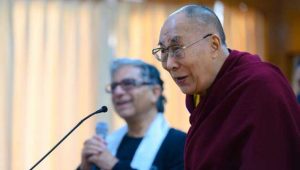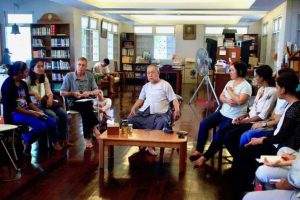
Hikosan, the tallest mountain in the northern part of Kyushu Island in Japan, has three distinct peaks, each of which is dedicated to both a Buddhist deity and a kami. During the Edo period (1603–1868), Hikosan was influential enough to have had its own branch of Shugendo, which all but disappeared in the second half of the 19th century.
Hikosan is located near the town of Soeda, in the southeastern part of Fukuoka Prefecture, adjacent to Oita Prefecture. The mountain is sometimes mentioned together with the Yoshino-Kumano and the Dewa Sanzan as one of the Nihon Daisan Shugendo—the three main Shugendo centers in Japan—attesting to its power and importance.
This month’s chapter in The Shugendo Diaries is based on my conversation with Ignas Čepelė from Lithuania, who is researching the Shugendo tradition on Hikosan in preparation for an MA thesis at Kyushu University.

BDG: Can you tell us a little about the historical context of Shugendo at Hikosan?
Ignas Čepelė: Although the opening up of practices on the mountain is legendarily attributed to an eighth century monk called Horen, it was not until the 10th century that the name Hikosan first appeared in written records. Hikosan reached the peak of its influence and prosperity in the 14th–16th centuries, when the Hikosan faith spanned all of Kyushu.
With the return of imperial rule and orders to separate Shintoism and Buddhism in the early Meiji period (late 19th century), the head priest of the Hikosan complex renounced his Buddhist priest’s license and became the head of the newly established Hikosan shrine, converted from a previously Buddhist complex.
Anti-Buddhist sentiment spread and resulted in strong religious persecution, leading to the destruction of most of Shugendo’s heritage and the discontinuation of the Shugendo tradition on the mountain.

BDG: Have there been any revival efforts at Hikosan?
IČ: The first half of the 20th century saw some limited efforts to restore Shugendo practices but these did not take root. Only after World War Two, in the 1950s, small yamabushi groups became more active in northern Kyushu and some limited Shugendo practices were resumed on Hikosan.
An important step in the return of Shugendo to Hikosan was the 1955 saito goma (outdoor fire ceremony). This saito goma was most likely the first since the destruction of Shugendo on Hikosan in the early Meiji period. It brought together hitherto separate yamabushi groups and also attracted large crowds of visitors.
Nevertheless, no single authority that could unite the separate yamabushi groups appeared over the years. Hence, no organized Hikosan Shugendo school exists, with most groups still having very few interactions.
Nowadays, there are a number of different players interested in Shugendo practices on Hikosan, including at least six yamabushi groups, Hikosan Jingu shrine, the Hikosan Monzenmachi (temple town) Association, the Soeda Town Guides’ Association, Buzenbo Tengu-ji temple, and Takasumi Jinja shrine.
Hikosan Jingu and the Hikosan Monzenmachi Association are the most active in their efforts to actually restore Shugendo culture and tradition on the mountain.

BDG: Can you tell us more about the efforts of these two players to restore Shugendo on Hikossan?
IČ: The Shugendo-related activities of Hikosan Jingu started around 10 years ago, when the head priest of the shrine decided that it was time to restore the Shugendo heritage on the mountain.
Since then, his son has taken qualifications for both Shinto and Buddhist priesthoods, becoming a rare example of a contemporary yamabushi who embodies both traditions. He has become the main person responsible for the Shugendo restoration at Hikosan Jingu.
Last year, the gegu (outer) shrine just above the main building of Hikosan Jingu was renovated and outfitted with an altar for the goma fire ritual. Since then, the priest has been performing a monthly goma ritual. Thus the gegu is the main center for Shugendo at Hikosan shrine and the monthly goma rite is the main activity, attracting a lot of visitors.
Other activities include the big saito goma performed in front of the main Hikosan Jingu building every November since 2016 (canceled in 2020 and 2021), as well as the restoration and creation of Shugendo-related material culture such as religious imagery.
The Monzenmachi Association is a non-religious group of people from around Hikosan who are interested in the mountain’s Shugendo history and culture. The chairman of this group is a descendant of high-ranking yamabushi and still lives in a bō (pilgrims’ lodge), which has changed very little since the Edo period. Even though there are more members in this group, he is the main driving force, coming up with activities, planning events, and doing most of the essential work.
This Monzenmachi Association offers guided tours around Hikosan, which are organized together with the Soeda Town Guides’ Association. Other activities include local craft workshops, the experience of staying at a pilgrims’ lodge, and taking caring of bō that have no owners.


BDG: Is there a larger context for the Shugendo revival, such as rural revitalization, tourism promotion, or conservation efforts?
IČ: I am not sure if the efforts to restore Shugendo can easily fit into a single category.
Hikosan is the main tourist attraction for Soeda, so there are definitely some tourism promotion efforts. Soeda gives some support to the Monzenmachi Association and to the Soeda Town Guides’ Association. They produce brochures for tourists and have also organized studies of Hikosan’s history. This support does not seem extensive though.
A member of the local revitalization group is also helping out with Monzenmachi activities, and some of the other members in the Monzenmachi Association have expressed interest in helping the people of Hikosan to sustain their traditions and to revitalize the local community. However, it seems that the main reason that drives efforts to restore Shugendo is people’s interest in Hikosan’s culture and its Shugendo history.
Actually, some of the main people behind this movement are descendants of Hikosan yamabushi. Hence, for them restoring Shugendo is a highly personal matter too. They feel that it is their precious heritage and the culture of their ancestors, which they want to preserve and pass on to future generations.

BDG: Lastly, what is your interest in Shugendo?
IČ: Contemporary Shugendo is interesting because of its diffusion and decentralization. There is no single Shugendo and for different people, the same word can have wildly different meanings, encompassing everything from eco-spirituality, to a philosophy of living, to a way to experience traditional Japanese culture.
I came across Shugendo during my BA studies looking for a topic for one of the papers. I decided to combine my passion for mountains and the outdoors with my interest in Japanese religions and the role of nature in them. I have been researching Shugendo since then.
I am interested in what Shugendo can teach us about the role of nature, especially mountains, in the Japanese religious worldview, and how it has shaped the way people interact with nature.
During my research about Hikosan I have met with many different people and heard their perspectives on Shugendo. I have been taking lessons from them that are now informing my own relationship with nature, mountains, and religious cultures.

Related features from BDG
Connecting the Past and Present of Shugendo – The Revival of Japan’s Ancient Mountain Ascetic Tradition, Part One
Connecting the Past and Present of Shugendo – The Revival of Japan’s Ancient Mountain Ascetic Tradition, Part Two
Connecting the Past and Present of Shugendo – The Revival of Japan’s Ancient Mountain Ascetic Tradition, Part Three
Connecting the Past and Present of Shugendo – The Revival of Japan’s Ancient Mountain Ascetic Tradition, Part Four
Connecting the Past and Present of Shugendo – The Revival of Japan’s Ancient Mountain Ascetic Tradition, Part Five
Connecting the Past and Present of Shugendo – The Revival of Japan’s Ancient Mountain Ascetic Tradition, Part Six
Connecting the Past and Present of Shugendo – The Revival of Japan’s Ancient Mountain Ascetic Tradition, Part Seven












